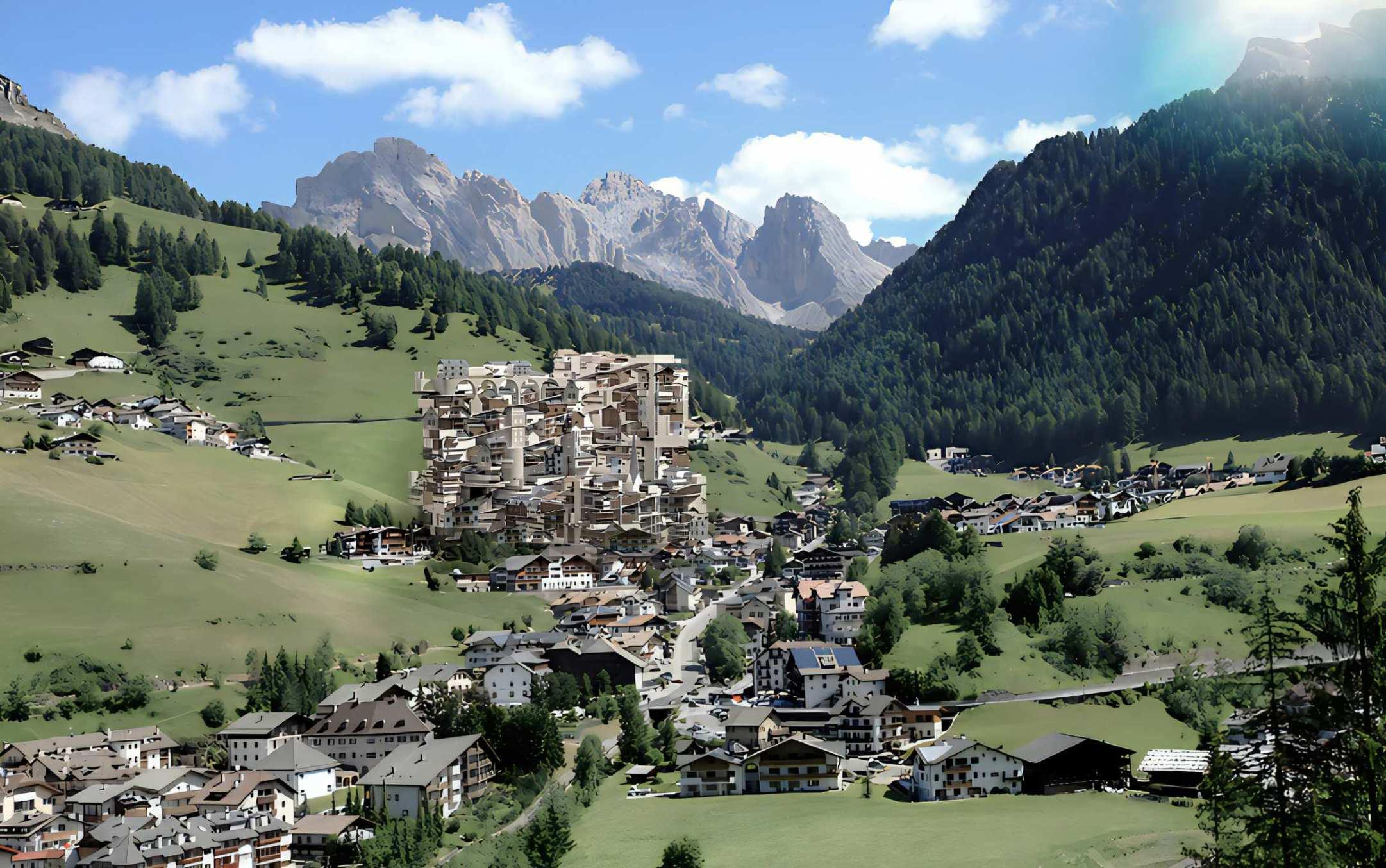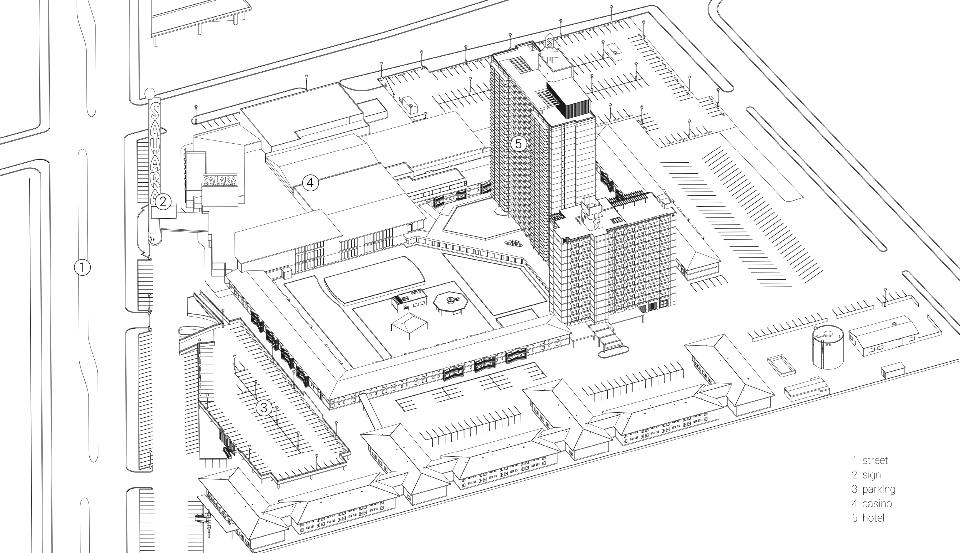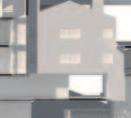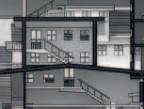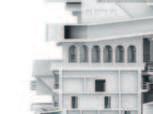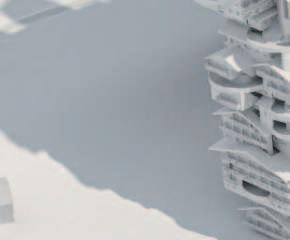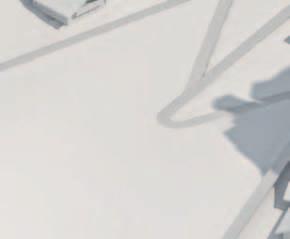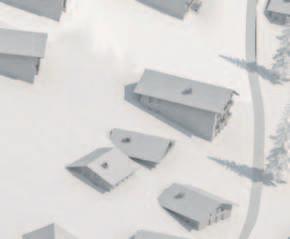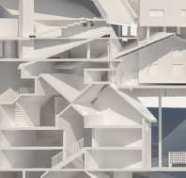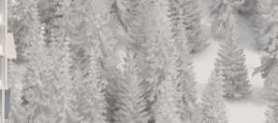Introduction
The Hotel as a Model of Urbanization
When we talk today about our cities, particularly our urban environment, we use statistics on how humans behave within our built environment. We explain the tendency of our living by graphs to give measurements of our intentions, or we show some diagrams to prove how our urban behaviors relate. While we might have given quantitative data to every behavior, we don9t research the formal understanding of our human environment. While cities are built of buildings, streets, parks, and public spaces, we hardly discuss their forms. What we gave up to ask ourselves is the quality of the form we want to live in.
The design research project on the Hotel as a model of urbanization intends to develop expertise in formally understanding our urban environment within metropolitan areas and our countryside. What we investigate is the architectural knowledge of our human environment, which gives form to our quantitative data. The intention is to examine new architectural forms of living environments.
There is no content without a form.
If we look into the history of urban design and planning, especially in Europe of the 19th, the 20th Century, and more recently into the 1st decade of the 21st Century, two essential accepts of urban design and development belonged to each other. One was understanding our spatial behavior through statistics, and the other gave form to it. When our cities grew within the 19th Century, the grid became its urban expansion model, and the urban block gave its architectural form. We can see the variation of such urban blocks throughout all our cities based on the various cultural differences in land ownership and housing typologies. At the beginning of the 20th century, the single-slab building emerged on a free piece of land mainly owned by the city. This architectural type became the model of our urban settlement before and after the 2nd World War. Both urban forms
were highly influenced by city and state governments9 involvement to increase the quality of our living environment.
In late capitalism and definitely, within the last twenty years, urban developments are executed by project next to the project, development next to the development. The question of form became replaced by the problem of what to invest in. Cities have given away the formal control of their cities.
What we witness today is what historically is known as the liberal urbanism of the 19th Century, an urban development without formal consciousness. What we need is research into the forms under which our cities evolve. It is the form in which we live, not its data.
In the recently published statistic on the behavior of the Austrian population within their urban environments by APA/Statistik Austria, a tendency became visualized, which can be found nearly anywhere within the European landscape of historically developed modes of inhabitation. While many cities in Austria grew immensely, from 14.1% in the town of Eisenstadt, 12.9% in Graz to 9.3% in the metropolitan city like Vienna and 8,4% in Innsbruck, the city of the Alps, small size towns or villages within the immediate distance to growing urban areas even exploded in terms of population growth by up to 30%. There is an enormous magnetic tendency that attracts people to move towards large urban metropolitan areas, while at the same time, historically established villages in the countryside empty out. This tendency is similar throughout Europe and even globally, while in Central Europe, within the Alps area, this tendency took on a particular form. The villages decreased by twofold: not only did these villages decrease in size and populations, but at the same time, their population changed from permanent inhabitants, a generation of people that found their economic existences within the imitate context of the village, to temporary inhabitants, like tourist, second home citizens and weekend dwellers which work or study during the week in metropolitan areas and speed their weekend back home. It can be argued that the village is not sustainable anymore, neither socially, economically, or even spatially.
Its form will die.
At the same time, a new architectural form emerged within the tourist areas of the Alps, namely, the high-rise building. The high-rise emerged as a particular form within high-density urban environments like Chicago and New York. The reason for the emergence of high-rise buildings was not only its potential to increase density but also the necessity to profit from the increasing land values within metropolitan areas. Today, any architectural form has lost its context and even emerges within an alpine area, whereby
its real quality can be witnessed, namely the high-rise building as a hotel containing all the city facilities. Therefore, the high-rise can be seen as a form of a town, a building that includes the life of a city.
One of our recent research projects has been the investigation within the last couple of years of the possible merge of the idea of a village and the idea of a hotel as a model of urbanization. The design investigation of this design research mainly developed forms of high-dense living environments based on a one-family house. While villages are constituted by many single-family dwellings spreading along roads, the design challenges were related to how it is possible to keep the individual home alive while reducing their related outdoor spaces and their form of access. Such a design investigation has happened throughout the history of urban design. It has its precursors in Le Corbusier Villa-Immeubles from 1925, many research projects within northern European countries from the 1950s to 1970, and recent design research projects in Asia, especially Japan.
The research aims to understand urban transformations as a problem of forms. The forms investigated are highly dense urban fabrics. These fabrics are intended not only to reintroduce aesthetics into our political considerations when planning our cities but also as the primary architectural forms that can solve sustainability problems. To live socially, economically, and materially sustainable, we must live in dense urban environments. The investigation of such forms is what we, as an institute of design, have developed as our expertise.
Innsbruck 2024
Peter Trummer
Works
CIRCUS CIRCUS & ST. CHRISTINA
JuliaPfeiffer|JohannaMaurer
SAHARA & SAALBACH-HINTERGLEMM
HannahRainer|CanÖtzunc
HOTEL PLANET HOLLYWOOD & SERFAUS MichelleNickels
CIRCUS CIRCUS & SERFAUS UND FISS
VeraBlasbichler|JasminWirth
ST. ANTON AM ARLBERG & HOTEL SAHARA JuliaRupprecht|LeonieVogl
CIRCUS CIRCUS & SERFAUS UND FISS
Sophie Elisabeth Gruner | Lena Marie Jenn
FALMINGO HOTEL & LECH AM ARLBERG
BenBogaczynski|Jean-NicolasTarnaud
SAHARA LAS VEGAS & SÖLDEN
Henning Jasper Dörner | Anita Krause
PLANET HOLLYWOOD & ST. CHRISTINA
Chiara Koch | Theresa Riedmann
SANDS HOTEL LAS VEGAS & SÖLDEN
Maximilian Moser | Jose Ferruono
PLANET HOLLYWOOD & ST.CHRISTINA
Nicola Kollreider | Lea Mailänder
SAHARA LAS VEGAS & SÖLDEN
Stephan Tiefenthaler
SANDS HOTEL LAS VEGAS & SÖLDEN
Daniel Eckelhofer| Miriam Meyer
CIRCUS CIRCUS & ST.CHRISTINA
Julia Pfeiffer | Johanna Maurer
ANALYSIS
St.Christinanoorplan
Julia Pfeiffer | Johanna Maurer
Julia Pfeiffer | Johanna Maurer
ANALYSIS
top: CirscusCircus bottom: St.Christina
Julia Pfeiffer | Johanna Maurer
ANALYSIS
top: houses
middle:streets
bottom: terrain
Julia Pfeiffer | Johanna Maurer
terrainintocirculation
Julia Pfeiffer | Johanna Maurer
CONCEPT
terrainintocirculation
Julia Pfeiffer | Johanna Maurer
CONCEPT
Julia Pfeiffer | Johanna Maurer
Julia Pfeiffer | Johanna Maure
Julia Pfeiffer | Johanna Maure
& SAALBACH-HINTERGLEMM
HannaRainer|CanÖtzunc
SAHARA
top: village middle: hotel bottom: circulationstreets
ANALYSIS HannaRainer|CanÖtzunc
top: houses middle: properties bottom: circulation
CONCEPT
top: connecton1&2 bottom: connection3&4
HOTEL PLANET HOLLYWOOD & SERFAUS
MichelleNickels
ANALYSIS
Serfausnoorplan
MicheleNickels
ANALYSIS
top: scale middle: publicspaces bottom: maincirculation
MichelleNickels
MichelleNickels
CONCEPT
Michelle Nickels
Michelle Nickels
Michele Nickels
PARIS & HOUSE STEINER
Julia Rupprecht | Leonie Vogl
ANALYSIS
St. Anton am Arlberg noorplan
Julia Rupprecht | Leonie Vogl
Julia Rupprecht | Leonie Vogl
ANALYSIS
Julia Rupprecht | Leonie Vogl
Hotel Sahara
ANALYSIS
Julia Rupprecht | Leonie Vogl
Hotel Sahara
top: staircase block middle: street block 1
bottom: street block 2
CONCEPT
Julia Rupprecht | Leonie Vogl
circulation
CONCEPT
Julia Rupprecht | Leonie Vogl
Julia Rupprecht | Leonie Vogl
CIRCUS CIRCUS & SERFAUS UND FISS
Vera Blasbichler | Jasmin Wirth
ANALYSIS
SerfausnoorplanFiss
Vera Blasbichler | Jasmin Wirth
VeraBlasbichler|JasminWirth
Entrance
top: CircusCircus middle: circulation ANALYSIS
top: circuscircus bottom: form
CONCEPT
top: circuscircus
bottom: noors+circulation
CONCEPT
VeraBlasbichler|JasminWirth
CONCEPT
VeraBlasbichler|JasminWirth
detailchunkFis
VeraBlasbichler|JasminWirth
CONCEPT
CIRCUS CIRCUS & SERFAUS UND FISS
Sophie Elisabeth Gruner | Lena Marie Jenn
ANALYSIS
LechamArlbergnoorplan
ANALYSIS
top: propertiesLechCenter middle: propertiesOberlech bottom: propertiesStubenbach
Sophie Elisabeth Gruner | Lena Marie Jenn
ANALYSIS
Sophie Elisabeth Gruner | Lena Marie Jenn
ANALYSIS
Sophie Elisabeth Gruner | Lena Marie Jenn
top: number1 middle: number2
CONCEPT
Sophie Elisabeth Gruner | Lena Marie Jenn
detailchunk
CONCEPT
Sophie Elisabeth Gruner | Lena Marie Jenn
FLAMINGO HOTEL & LECH AM ARLBERG
Ben Bogaczynski | Jean Nicolas Traud
ANALYSIS
LechamArlbergnoorplan
Ben Bogaczynski | Jean Nicolas Traud
ANALYSIS
Lech-circulation
Ben Bogaczynski | Jean Nicolas Traud
top: casino bottom: hotel
CONCEPT
Ben Bogaczynski | Jean Nicolas Traud
left: circulationhotel
right: circulationLech
CONCEPT
Ben Bogaczynski | Jean Nicolas Traud
CONCEPT
Ben Bogaczynski | Jean Nicolas Traud
CONCEPT
Ben Bogaczynski | Jean Nicolas Traud
top: chunkdetail1 bottom: chunkdetail2
CONCEPT
Ben Bogaczynski | Jean Nicolas Traud
top: chunkdetail3 bottom: chunkdetail4
CONCEPT
Ben Bogaczynski | Jean Nicolas Traud
SAHARA LAS VEGAS & SÖLDEN
Henning Dörner |Anita Krause
Söldennoorplan
HenningJasperDörner|AnitaKrause
ANALYSIS
HenningJasperDörner|AnitaKrause
HotelSaharaLasVegas
ANALYSIS
ANALYSIS
groundnoorplanHotelSahara
HenningJasperDörner|AnitaKrause
living space functions
casino, lobby, shops, spa
top: hotel bottom: village
supermarket, church, school, o ce
property line
HenningJasperDörner|AnitaKrause
CONCEPT
CONCEPT
top: village+villagetypology
middle: hotel +hoteltypology
bottom: village+hotel
HenningJasperDörner|AnitaKrause
top: casino middle: hotel
CONCEPT
HenningJasperDörner|AnitaKrause
top: intersection middle: levelincrease
CONCEPT
HenningJasperDörner|AnitaKrause
CONCEPT
HenningJasperDörner|AnitaKrause
projectarrangement
projectarrangement
HenningJasperDörner|AnitaKrause
CONCEPT
CONCEPT
HenningJasperDörner|AnitaKrause
CONCEPT
+120.75
+89.50
PLANET HOLLYWOOD & ST. CHRISTINA
Chiara Koch | Theresa Riedmann
ANALYSIS
Chiara Koch | Theresa Riedmann
St.Christinanoorplan
Chiara Koch | Theresa Riedmann
ANALYSIS
Chiara Koch | Theresa Riedmann
top: hotelform bottom: hotelnoors
Chiara Koch | Theresa Riedmann
hotelcirculation ANALYSIS
ANALYSIS
Chiara Koch | Theresa Riedmann
top: hotelorstnoor bottom: hotelseconnoos
ANALYSIS
hotelsection
Chiara Koch | Theresa Riedmann
Chiara Koch | Theresa Riedmann
top: streetarrangement bottom: St.Christina
CONCEPT
Chiara Koch | Theresa Riedmann
top: houseandstreetarragement bottom: St.Christina
CONCEPT
CONCEPT
Chiara Koch | Theresa Riedmann
top: publicarrangement bottom: hotelpart
Chiara Koch | Theresa Riedmann
top: projectarrangement bottom: hotelpart
CONCEPT
SANDS HOTEL LAS VEGAS & SÖLDEN
Maximilian Mooser | Jose Ferruono
ANALYSIS
Maximilian Mooser | Jose FerruonoMaximilian
CONCEPTS
privateandpublichousing
arrangement
includingcirculation
left:
middle:
right:
FerruonoMaximilian Mooser | Jose Ferruono
top: CirscusCircus bottom: St.Christina
ANALYSIS
Julia Pfeiffer | Johanna Maurer
top: houses middle: streets
bottom: terrain
ANALYSIS
Julia Pfeiffer | Johanna Maurer
top: CirscusCircus bottom: St.Christina
ANALYSIS
Julia Pfeiffer | Johanna Maurer
top: houses middle: streets
bottom: terrain
ANALYSIS
Julia Pfeiffer | Johanna Maurer
PLANET HOLLYWOOD & ST. CHRISTINA
Nicola Kollreider | Lea Mailänder
ANALYSIS
Nicola Kollreider | Lea Mailänder
St.Christinanoorplan
Tennis Cour
Ski School
Soc Fire Station Community Primary School Church Rescue Center
Cable Car Tunnel
Fischburg Tunnel
Cable Car
Field
Gardena Express
Cable Car
Middle School
Nicola Kollreider | Lea Mailänder
ANALYSIS
Nicola Kollreider | Lea Mailänder
top: LuxorHotelRooms bottom: sideview
Nicola Kollreider | Lea Mailänder
CONCEPT
Nicola Kollreider | Lea Mailänder
top: modiocationhousesandhotelrooms bottom: collection
houseandstreetarrangement
Nicola Kollreider | Lea Mailänder
CONCEPT
CONCEPT
Nicola Kollreider | Lea Mailänder
building method
CONCEPT
new arrangement
Nicola Kollreider | Lea Mailänder
Nicola Kollreider | Lea Mailänder
CONCEPT
Nicola Kollreider | Lea Mailänder
SAHARA LAS VEGAS & SÖLDEN
Stefan Tiefntahler
StefanTiefentahler
Saalbachproperties
ANALYSIS
ANALYSIS
MAIN STREETS SIDE STREETS
Saalbachstreets
StefanTiefentahler
ANALYSIS
StefanTiefentahler
CesarPalace
HOTELROOMS CIRCULATION
MAIN ENTRENCE
CASINO
COLLOSEUM
SHOPS
ANALYSIS
StefanTiefentahler
CONCEPT
villageproperties
StefanTiefentahler
conogurations
StefanTiefentahler
CONCEPT
StefanTiefentahler
top: serpentinesSaalbach bottom: streetsectionSaalbach
CONCEPT
CONCEPT
top: serpentineintegrationproject bottom: streetsectionintegrationproject
StefanTiefentahler
top: spublicspaces middle: stairsystem bottom: streetsystem
StefanTiefentahler
CONCEPT
detail
CONCEPT
StefanTiefentahler
0m10m 20m30m 40m50m
SANDS & SAALBACH-HINTERGLEMM
Miriam Meyer | Daniel Eckelhofer
ANALYSIS
Miriam Meyer | Daniel Eckelhofer
Saalbach noorplan
ANALYSIS
Saalbachstreets&housing
Miriam Meyer | Daniel Eckelhofer
ANALYSIS
Miriam Meyer | Daniel Eckelhofer
Cesar Palace
ANALYSIS
Miriam Meyer | Daniel Eckelhofer
top: privatepropertiearrangement bottom: includingcirculation
CONCEPT
Miriam Meyer | Daniel Eckelhofer
Miriam Meyer | Daniel Eckelhofer
top: includingpublicspace bottom: elevation
CONCEPT
Miriam Meyer | Daniel Eckelhofer
tower
CONCEPT
Miriam Meyer | Daniel Eckelhofer
This book has been onanced by the Institute of Urban Design 3IOUD, University of Innsbruck.
IMPRESSUM 2023
IOUD
Institute of Urban Design / Universtität Innsbruck
Univ.-Prof. Peter Trummer
Technikerstraße 21c
6020 Innsbruck AUSTRIA


